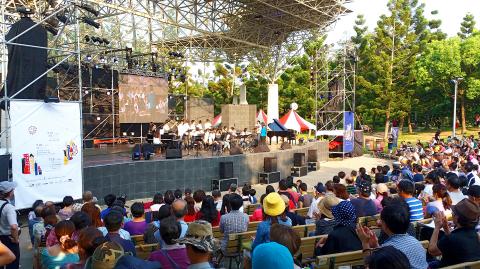The Taipei Jazz Festival (台北爵士音樂節) turns 10 this year, and celebrates by adding two indoor shows featuring international heavyweights and a newcomer competition to its existing program of a weekend of live music in Da-an Forest Park.
The indoor shows are held at Zhongshan Hall, featuring an American All-star lineup of guitarist Dean Brown, bassist Stuart Hamm and drummer Chris Coleman tonight and the TJF Collective tomorrow, headlined by Panamanian saxophonist Carlos Agrazal and violinist Joshue Ashby Humphreys.
The usual program at Da-an Park’s bandshell will feature a mix of local and international talent, with sounds ranging from fusion to big band to middle eastern-tinged grooves featuring the oud, an Arabic pear-shaped stringed instrument.

Photo: Han Cheung, Taipei Times
In addition, the festival hosted master classes this week and several mini-concerts and jazz appreciation seminars in the past two months, expanding its repertoire in jazz education and promotion.
■ The indoor shows are tonight and tomorrow from 5:30pm 7:30pm at 98, Yanping S Rd, Taipei City (台北市延平南路98號). General admission is NT$500; NT$300 for students.
■ The outdoor shows are tonight through Sunday from 3pm to about 10pm. Admission is free, and the bandshell is located near the center of the park.
■ For more information, visit jazz.festival.taipei/2016/ (Chinese only)

May 26 to June 1 When the Qing Dynasty first took control over many parts of Taiwan in 1684, it roughly continued the Kingdom of Tungning’s administrative borders (see below), setting up one prefecture and three counties. The actual area of control covered today’s Chiayi, Tainan and Kaohsiung. The administrative center was in Taiwan Prefecture, in today’s Tainan. But as Han settlement expanded and due to rebellions and other international incidents, the administrative units became more complex. By the time Taiwan became a province of the Qing in 1887, there were three prefectures, eleven counties, three subprefectures and one directly-administered prefecture, with

It’s an enormous dome of colorful glass, something between the Sistine Chapel and a Marc Chagall fresco. And yet, it’s just a subway station. Formosa Boulevard is the heart of Kaohsiung’s mass transit system. In metro terms, it’s modest: the only transfer station in a network with just two lines. But it’s a landmark nonetheless: a civic space that serves as much more than a point of transit. On a hot Sunday, the corridors and vast halls are filled with a market selling everything from second-hand clothes to toys and house decorations. It’s just one of the many events the station hosts,

Among Thailand’s Chinese Nationalist Party (KMT) villages, a certain rivalry exists between Arunothai, the largest of these villages, and Mae Salong, which is currently the most prosperous. Historically, the rivalry stems from a split in KMT military factions in the early 1960s, which divided command and opium territories after Chiang Kai-shek (蔣介石) cut off open support in 1961 due to international pressure (see part two, “The KMT opium lords of the Golden Triangle,” on May 20). But today this rivalry manifests as a different kind of split, with Arunothai leading a pro-China faction and Mae Salong staunchly aligned to Taiwan.

Two moves show Taichung Mayor Lu Shiow-yen (盧秀燕) is gunning for Chinese Nationalist Party (KMT) party chair and the 2028 presidential election. Technically, these are not yet “officially” official, but by the rules of Taiwan politics, she is now on the dance floor. Earlier this month Lu confirmed in an interview in Japan’s Nikkei that she was considering running for KMT chair. This is not new news, but according to reports from her camp she previously was still considering the case for and against running. By choosing a respected, international news outlet, she declared it to the world. While the outside world